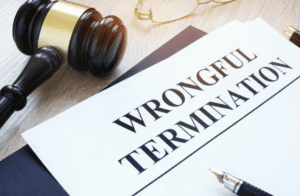 Have you received unwanted sexual comments, jokes, or advances at work? Was a significant employment decision such as a promotion denied (or granted) based on your rejection (or acceptance) of a sexual advance?
Have you received unwanted sexual comments, jokes, or advances at work? Was a significant employment decision such as a promotion denied (or granted) based on your rejection (or acceptance) of a sexual advance?
If the answer to either of these questions is yes, you are likely the victim of sexual harassment as defined by the Equal Employment Opportunity Commission (EEOC). But how do you stop this sexual harassment?
One simple way is to privately ask the harasser to stop engaging in conduct that constitutes sexual harassment. But this is usually easier said than done, given the work relationship between you and the harasser. Also, if you’re disciplined or if you need to take legal action in the future, you may have a difficult time proving sexual harassment.
Table of Contents
ToggleWhat Constitutes Sexual Harassment?
Federal law prohibits sexual harassment at work under Title VII of the Civil Rights Act of 1964. Sexual harassment can include requests for sexual favors, sexual jokes, or other forms of unwanted verbal or physical conduct of a sexual nature. Most individuals recognize these behaviors as sexual harassment, but sometimes the sexual harassment is more subtle or between individuals where you may not think sexual harassment can exist. For example, the victim of sexual harassment can be either a man or woman, as can the harasser. This means sexual harassment can occur between two people of the same sex.
Sometimes, casual comments or isolated incidents of a sexual nature do not rise to the level of sexual harassment, as defined by federal law. Also, if you welcome the sexual conduct, it doesn’t constitute sexual harassment (although this could lead to other workplace problems).
Because conduct that is seemingly sexual harassment may not actually be sexual harassment, or because a sexual harassment allegation can consist of a “he-said/she-said” situation, you need to take certain reporting steps to stop the sexual harassment and satisfy federal law.
How to Report Sexual Harassment
Under the law, there are three ways to stop the sexual harassment by reporting the unwanted conduct:
- You can report it to the proper workplace officer or supervisor.
- You can tell the harasser to stop the unwanted behavior in front of witnesses.
- You can file a complaint with the EEOC.
Reporting the Sexual Harassment to the Proper Workplace Officer or Supervisor
 One of the first things you can do to stop the sexual harassment is report it to your boss, human resources officer, or other individual designated by your employer’s formal sexual harassment reporting procedure. If no formal procedure identifies who you should report the sexual harassment to, inform a supervisor who is able to “take tangible employment action” against you. Vance v. Ball State University, 133 S. Ct. 2434 (2013). What this means is that the person you report the sexual harassment to must have the power to fire, demote, or discipline you. This also means that a supervisor, as far as sexual harassment reporting is concerned, does not include someone who merely oversees your daily activities or tells you when you need to come into work.
One of the first things you can do to stop the sexual harassment is report it to your boss, human resources officer, or other individual designated by your employer’s formal sexual harassment reporting procedure. If no formal procedure identifies who you should report the sexual harassment to, inform a supervisor who is able to “take tangible employment action” against you. Vance v. Ball State University, 133 S. Ct. 2434 (2013). What this means is that the person you report the sexual harassment to must have the power to fire, demote, or discipline you. This also means that a supervisor, as far as sexual harassment reporting is concerned, does not include someone who merely oversees your daily activities or tells you when you need to come into work.
For example, let’s say you wait tables in a restaurant and suffer sexual harassment from a co-worker. The assistant manager oversees your daily activities and makes scheduling decisions but does not have the power to fire you or discipline you for misconduct. However, the manager does have that power. Under Vance v. Ball State University, you would need to report the sexual harassment to the manager and not the assistant manager.
This may seem confusing, as evidenced by Judge Richard Posner’s article on Slate.com titled “Supreme Court 2013: The Year in Review – A Disappointing Supreme Court Decision on Sexual Harassment,” as well as the fact that workplaces all over the country have employees who have the power to discipline other employees but not hire or fire them, or vice versa.
Asking the Harasser to Stop the Unwanted Conduct in Front of Witnesses
A second option to stop workplace sexual harassment is to ask the harasser to stop when you’re in front of witnesses. This can be an in-person conversation with other co-workers present and involved in the conversation or an e-mail to the harasser, with your boss and/or human resources officer copied on the message.
This is understandably a difficult option, since it requires confronting the harasser regarding the sexual harassment. However, it will establish that you tried to stop the conduct and informed the harasser that it was unwanted.
One defense or excuse often made by sexual harassers is that the victim wanted and encouraged the behavior or never explained that it was unwanted. This may be a legitimate explanation for the sexual harassment, or it may just be a lie. Either way, asking the harasser to stop the conduct with proof is necessary, especially if further internal or legal action is taken.
File a Complaint with the EEOC
A third option is to file a complaint with the EEOC. The methods and procedures can be found on the “How to File a Charge of Employment Discrimination” portion of the EEOC’s website. One important thing to mention is that you can file a complaint, or “charge” as the EEOC calls it, even though you are still employed. You do NOT have to wait until you resign or are fired to file the charge. Waiting to file the complaint does not mean all hope is lost, but it can make things more difficult, assuming you want to get your job back.
Another option to deal with the sexual harassment is to speak with an attorney. Nolo.com’s article titled “Sexual Harassment: When You Should Talk to a Lawyer” provides a good starting point. While many sexual harassment situations can be effectively handled without outside legal help, seeking the advice of an attorney may be necessary depending on the facts of your case.





